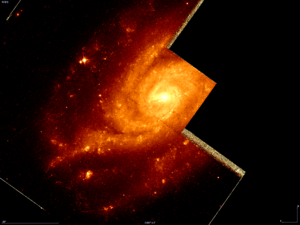NGC 7689
| Galaxy NGC 7689 |
|
|---|---|

|
|
| Photo from the Hubble Space Telescope | |
| AladinLite | |
| Constellation | Phoenix |
|
Position equinox : J2000.0 , epoch : J2000.0 |
|
| Right ascension | 23 h 33 m 16.7 s |
| declination | -54 ° 05 ′ 40 ″ |
| Appearance | |
| Morphological type | SA (r) c |
| Brightness (visual) | 11.5 likes |
| Brightness (B-band) | 12.2 mag |
| Angular expansion | 2.9 ′ × 1.9 ′ |
| Position angle | 135 ° |
| Surface brightness | 13.2 mag / arcmin² |
| Physical data | |
| Affiliation | isolated |
| Redshift | 0.006571 ± 0.000017 |
| Radial velocity | 1970 ± 5 km / s |
|
Stroke distance v rad / H 0 |
(85 ± 6) x 10 6 ly (26.0 ± 1.8) Mpc |
| history | |
| discovery | James Dunlop |
| Discovery date | September 5, 1826 |
| Catalog names | |
| NGC 7689 • PGC 71729 • ESO 192-007 • IRAS 23305-5422 • 2MASX J23331672-5405401 • SGC 233031-5422.2 • GC 4978 • h 3996 • HIPASS J2333-54 • 2MIG 3172 | |
NGC 7689 is a barred spiral galaxy of the Hubble type SBc in the constellation Phoenix in the southern sky . It is estimated to be 85 million light years from the Milky Way and about 70,000 light years in diameter.
The type II supernova SN 1996al was observed here.
The object was discovered by James Dunlop on September 5, 1826 .
Web links
Commons : NGC 7689 - collection of images, videos, and audio files
